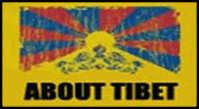

Introduction
The geography of Tibet is comprised of the high mountains, lakes and rivers of central Asia. Tibet is often called "the roof of the world", comprising table-lands averaging over 4,950 metres above the sea with peaks at 6,000 to 7,500 m, including Mount Everest. It is bounded on the north and east by China, on the west by the Kashmir Region of India and on the south by Nepal, Bangladesh and Bhutan. Most of Tibet sits atop a geological structure known as the Tibetan Plateau which includes the Himalaya and many of the highest mountain peaks in the world.
ProvincesTibet lies at the centre of Asia, with an area of 2.5 million square kilometers. The earth's highest mountains, a vast arid plateau and great river valleys make up the physical homeland of 6 million Tibetans. It has an average
altitude of 13,000 feet above sea level. Tibet is comprised of the three provinces of Amdo (now split by China into the provinces of Qinghai, Gansu & Sichuan), Kham (largely incorporated into the Chinese provinces of Sichuan, Yunnan and Qinghai), and Ü-Tsang (which, together with western Kham, is today referred to by China as the Tibet Autonomous Region).
The Tibet Autonomous Region (TAR) comprises less than half of historic Tibet and was created by China in 1965 for administrative reasons. It is important to note that when Chinese officials and publications use the term "Tibet" they mean only the TAR. Tibetans use the term Tibet to mean the three provinces described above, i.e., the area traditionally known as Tibet before the 1949-50 invasion.
Amdo
Amdo is one of the three former provinces of Tibet, the other two being Ü-Tsang and Kham; it is also the place from which Tenzin Gyatso, the 14th Dalai Lama, comes from. The Tibetan cultural sphere of Amdo is one of the most important and varied within the Tibetan Plateau. There are many dialects of the Amdo language due to the geographical isolation of many tribal groups. The (Tibetan) inhabitants therefore call themselves Amdowa (a mdo pa), and not Böpa (bod pa), as the Tibetan designation for (central) Tibetans suggests.
Amdo was and is the home of many important Tibetan Buddhist monk teachers or lamas who had a major influence on both the politics and religious development of Tibet, like the great reformer Tsongkhapa, the 14th Dalai Lama as well as the 10th Panchen Lama. It is, therefore, a region spotted with many Buddhist monasteries - with Kumbum Jampa Ling (Chin. Ta'er Si) near Xining, Qutan Si and Labrang Tashi Khyil south of Lanzhou being among the most famous and important within the Tibetan cultural realm.
Ü-Tsang
Ü-Tsang is the cultural heartland of the Tibetan people. The present Tibet Autonomous Region corresponds approximately to what was ancient Ü-Tsang and western Kham.
KhamKham comprises a total of 50 contemporary counties, distributed between the Chinese provinces of Sichuan (16 counties), Yunnan (3 counties), and Qinghai (6 counties) as well as the eastern portion of the Tibet Autonomous Region (25 counties). Kham has a rugged terrain characterized by mountain ridges and gorges running from northwest to southeast. Numerous rivers, including the Mekong, Yangtze, Yalong Jiang, and the Salween flow through Kham.
Environmental data describe on the geographic features of Tibet.
AREA = 2.5 million sq. km. Approximately the size of Western Europe
AVERAGE ALTITUDE = 14,000 Feet
AVERAGE TEMPERATURE = July 58 F; January 24 F.
AVERAGE RAINFALL = Wide Range: in western areas: 1mm in January to 25mm in July; in the eastern areas: 25 to 50mm in January to 800mm in July
TERRAIN = 70% Grassland; From high plateau to tropical forest
MAJOR RIVERS = Mekong, Yangtze, Salween, Tsangpo, Yellow, Indus, Karnali,
LAKES = 15,000+; including: Lake Kokonor, Lake Yamdrok, Namtso Yumbo
MAMMALS = 210 species; including: Wild Yak, Bharal (blue sheep), Musk deer, Tibetan Antelope, Tibetan gazelle, Kyang (wild ass), Pica
BIRDS = 532 species; including: Black necked crane, Lammergeier, Great crested grebe, Bar headed goose, Ruddy Shel duck, Ibis-bill
FOREST TYPES = Tropical and Sub-tropical montane coniferous forests:
FOREST COVER = 1949: 221,800 sq. km.; 1985: 134,000 sq. km. (almost 50% reduction)
TYPICAL TREES = Spruce, Fir, Pine, Larch, Cypress, Birch, Oak
PROVINCES = U-Tsang, Amdo, Kham
PLANTS = 12,000+ species of plants; including: 400 species of Rhododendron (50% of world's total species), 2000+ medicinal plants
MINERALS = 126 total; including: Borax, uranium (world's largest uranium reserve), iron, chromite, gold, copper, iron, lithium
MAIN FOOD CROPS = Barley, wheat, maize, muatard, millet, sorghum
MAIN VEGETABLES = cabbage, cauliflour, lettuce, radish, turnip, peas, celery, carrot, potato
ECOSYSTEMS = forest, scrub, steppe desert, aquatic
BORDERING COUNTRIES = India, Nepal, Bhutan, Burma, China
POPULATION = 6 million Tibetans; estimated 7.5 million Chinese in Kham, Amdo










Web designed and developed by: Tenzin Sherab (Longsho leader) with funding from National Endownment for Democracy (NED)